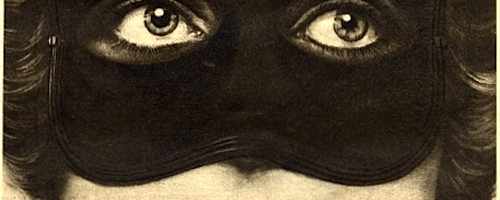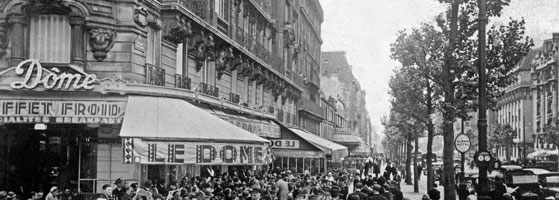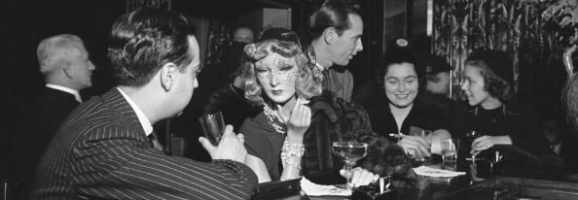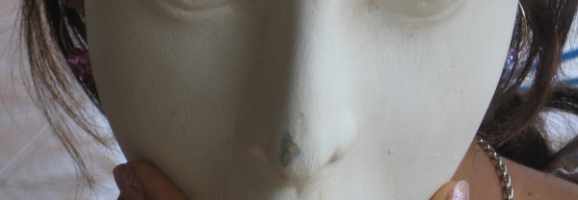Good Morning, Midnight: Masks and Consequences
There will be time, there will be time
To prepare a face to meet the faces that you meet;
. . . And time yet for a hundred indecisions,
And for a hundred visions and revisions,
Before the taking of toast and tea.
— T.S. Eliot, “The Love Song of J. Alfred Prufrock”
In his famous early poem, Eliot writes of man’s penchant for hiding behind masks of his own making. In her essay, “The Self Impersonation In World Literature,” Dr. Wendy Doniger confirms Eliot’s notion and argues that the masks people wear are not so far removed from the true face that lies beneath.
People masquerade as themselves all the time; the mythology of self-imitation stretches from ancient India to Hollywood and prevails in real life as well as fiction, which is sometimes, contrary to public opinion, stranger than truth. (102)

Doniger mentions literature in her argument and, indeed, the theme of wearing masks is a common one. However, in Jean Rhys’s Good Morning, Midnight (1938), the consequences of removing one’s mask reveals the dangers which arise from such an act. The masks people wear, and the consequences of removing them, pervades Rhys’s novel. For the book’s protagonist, Sasha Jensen, removing her mask results in her embrace of death.
The mask Sasha Jensen wears acts as a buffer of self-defense. She has crafted it, over many years, with the tears of rejection and abuse. Her entire life encompasses sadness. Early in the novel, Sasha, who is visiting Paris for the second time, with the intention of drinking herself to death, dreams of her father:
Now a little man, bearded, with a snub nose, dressed in a long white night-shirt, is talking earnestly to me. ‘I am your father,’ he says. ‘Remember that I am your father.’ But blood is streaming from a wound in his forehead. ‘Murder,’ he shouts, ‘murder, murder.’ Helplessly I watch the blood streaming. At last my voice tears itself loose from my chest. I too shout: ‘Murder, murder, help, help,’ and the sound fills the room. (13)
By dreaming of her father, Sasha hints at how far back her desolation extends. The blood running from the wound in his head literally implies their bloodline and the damage inflicted to it. He calls her a murderer because she actively seeks to forget him, and, by extension, her past. Sasha returns the accusation, knowing full well the futility of her desire. In fact, by deciding to visit the French capital again, she dives head-first into the pool of her memories regarding the earlier Paris visit. In considering Doniger’s view, Sasha goes back to Paris wearing a mask which will reveal her true self as she re-visits the locations and memories of her earlier trip.
One of her most vivid memories concerns a meeting with the owner of a dress shop through which she is employed. From the onset, a terrified Sasha wishes for the masks she will one day wear so well. “Don’t let him notice me, don’t let him look at me. Isn’t there something you can do so that nobody looks at you or sees you? Of course, you must make your mind vacant, neutral, then your face also becomes vacant, neutral—you are invisible” (19).
At first reading, this passage might seem to contradict the idea of the mask. Perhaps, one recalls Halloween, with its ritual of covering one’s face with another. However, invisibility completely covers up what is perceived. Is this not a mask? From classical mythology to Harry Potter’s “cloak of invisibility”, the act of making one’s self invisible involves utilizing, perhaps, the ultimate mask.
Predictably, given Sasha’s paranoia, the meeting proceeds awkwardly. At one point, Mr. Blank inquires about her ability to speak French:
I say: ‘I speak French fairly well. I’ve been living in Paris for eight years.’
No, he’s suspicious now. Questions short and sharp.
‘How long have you been working here?’
‘About three weeks.’
‘What was your last job?’
‘I worked at the Maison Chose in the Place Vendôme.’
‘Oh, really, you worked for Chose,’ His voice is more respectful. ‘Were you receptionist there?’
‘No,’ I say. ‘I worked as a mannequin.’
‘You worked as a mannequin?’ Down and up his eyes go, up and down. ‘How long ago was this?’ he says.
How long ago was it? Now, everything is a blank in my head—years, days, hours, everything is a blank in my head. How long ago was it? I don’t know.
(20-21)
Much may be ascertained from this remarkable passage. First, there is the name of the dress shop owner, Mr. Blank. One may wonder as to the veracity of the name Sasha gives him. In Jean Rhys: A Critical Study, Thomas F. Staley writes, “‘Mr. Blank’ becomes the archetype of all those forces which hold her hostage.” He goes on to argue, “The malignancy of the faceless and nameless oppressor is seen more clearly by Sasha than by any of Rhys’s other heroines. From this combination of paranoia and insight, Sasha recognizes those forces in society which turn her into a weak and helpless figure who simply cannot get on” (86).
In Sasha’s mind, Mr. Blank is no different than Rene, or the old man who continually haunts her from the hotel room next door. Her life, to this point, has been a continual line of men who have harmed her in some way. Sasha perceives all of these men to be one entity, to whom she assigns a different mask. Therefore, we have “Mr. Blank”, “the gigolo”, “the commis”, and so forth.
Recalling the conversation with Mr. Blank, when asked about her previous job, Sasha refers to herself as a mannequin. This is a fitting term for someone attempting to drift through life unnoticed. It also associates itself perfectly with Sasha’s description of invisibility: vacant and neutral. Mannequins fill department store windows, dressed to the nine’s with the latest fashions. Yet, all of the figures are exactly alike. The eyes, nose, lips, the contour of the face—lifeless; the body, stiff and disposable—all the same. Sasha literally wants to experience life as a mannequin would; which is to say, she wants to feel nothing at all.

Finally, the passage ends with Sasha unable to discern events in time. Perhaps, due to her nervousness, this is understandable. However, this also acts as a barometer for the rest of the novel. As Sasha descends down her inevitable road to ruin, memories begin to overtake her. She loses sight of her mask and the masks she assigns to others. By the end of the novel, present and past intertwine as she willingly slips into a final abyss from which she will not return.
Going through life unnoticed, in Sasha’s mind, is an impossibility. In her return visit to Paris, she feels as though she is always recognized when re-entering her old haunts. Given her paranoidal instincts, this is probably a false assessment. However, in her mind, a trip to a favorite restaurant dissolves into a nightmare of humiliation.
I light a cigarette and drink the coffee slowly. As I am doing this two girls walk in . . . Theodore waddles up to their table and talks to them. The tall girl speaks French very well. I can’t hear what Theodore is saying, but I watch his mouth moving and the huge moon-face under the tall chef’s cap.
The girls turn and stare at me.
‘Oh, my God!’ the tall one says.
Theodore goes on talking. Then he too turns and looks at me. ‘Ah, those were the days,’ he says.
‘Et qu’est-ce qu’elle fout ici, maintenant?’ the tall girl says, loudly.
Now everybody in the room is staring at me; all the eyes in the room are fixed on me. It has happened. (50)
This passage illustrates the extent to which paranoia contaminates Sasha’s perception of the outside world. What begins with one girl staring at Sasha turns into every face in the room fixating on her. Even more chilling is Sasha’s perception that the city itself—its physical structures—watches over her. She imagines “walking in the night with dark houses over you, like monsters . . . Frowning and leering and sneering, the houses one after another” (32).
Unable to exist unseen by the outside world, Sasha decides to mask herself visibly. According to Mary Lou Emery, in Jean Rhys at “World’s End”, “Sasha does what some anthropologists claim people do everywhere when the danger of death looms too menacingly—she invents a ritual” (152). She decides to dye her hair. Later, she will buy a new hat, and later still, some new clothes. Sasha does this, again, in an effort to hide her sad life behind a mask. After buying her hat, which she refers to as an “extraordinary ritual”, Sasha feels a rare sense of giddiness. “I feel saner and happier after this. I go to a restaurant near by and eat a large meal, at the same time carefully watching the effect of the hat on the other people in the room, comme ςa. Nobody stares at me, which I think is a good sign” (70).

This would seem to indicate a small breakthrough. After all, Sasha admits that she does not care what other people think of her hat. However, she still takes the time to observe the faces of the other patrons in the restaurant. If she really did not care what they thought, she would not have bothered to look for their reactions. More disturbing still, as Joy Castro argues in her critical essay, “Jean Rhys,” Sasha’s attempts at transformation “can be seen as a complete erasure of Sasha’s personality.” Castro sees Sasha’s hair dye, in particular, as the “final relinquishment of individual vision, of the ability to perceive (if not control) her own life in an original way” (20).
Given Sasha’s inability to physically mask herself to satisfaction, her relationships with men—the root of her mental disarray— prove disastrous. Consider, again, Mr. Blank. Having already botched their initial meeting, Sasha describes a later incident wherein she is summoned to his office and asked to deliver a letter to the cashier. She misinterprets his German, and finds herself walking in circles, unsure of who to deliver the letter to: “Kise—kise . . . It doesn’t mean a thing to me. He’s got me in such a state that I can’t imagine what it can mean” (25).
After some time, she gives up and, upon seeing Mr. Bank, admits to not knowing where to deliver the letter.”‘Extraordinary,’ he says, very slowly, ‘quite extraordinary. God knows I’m used to fools, but this complete imbecility . . . This woman is the biggest fool I’ve ever met in my life. She seems to be half-witted. She’s hopeless’” (27). Finally, Mr. Blank asks her, “‘Just a hopeless, helpless little fool aren’t you?’” After initially resisting his bait, Sasha answers, “‘Yes, yes, yes, yes. Oh, yes’” (28).
As previously mentioned, Mr. Blank encompasses, by the very name Sasha assigns him, all of the men who have humiliated and degraded her. His mask is, literally, a blank face—to Sasha, he embodies a type, not a person. Ironically, he sees her as the mannequin she longs to be. He does not consider her feelings when he belittles her. Why would he? She is not a real person in his eyes. Nor does he spend one second thinking about her when she quits her job. She is quickly forgotten.
Likewise, Sasha’s relationship with her husband, Enno, the only man for whom she wears no mask, ends with him leaving her. Interestingly, Sasha never describes his face. He exists in her memories as something of a blur. Having met in London, Sasha’s first visit to Paris is the result of Enno’s desire to go back to his homeland. During their time together, the couple struggles financially, and Sasha gives birth to a stillborn baby. Enno leaves her twice, the first time because, “‘You don’t know how to make love . . . You’re too passive, you’re lazy, you bore me. I’ve had enough of this. Good-bye’” (128).
His second goodbye is final and Sasha’s mind, already teetering on the edge of insanity, begins its slow, unavoidable journey to self-destruction. “Did I love Enno at the end? Did he ever love me? I don’t know. Only, it was after that that I began to go to pieces. Not all at once, of course. First this happened, and then that happened” (143).
It is at this point, after Enno’s departure, that Sasha begins to create the mask that will lead her back to Paris. After a five-year stay in London, during which she begins drinking to excess, passing her days in bars, and spending her nights in hotel rooms, Sasha hits rock bottom. Doniger writes of the loss of self,
As we go deeper and deeper through the alternating layers of masks and faces, we never reach a core; the depilatory process is endless, always shedding a self, as snakes slough their skins… every time you take off a mask you get halfway closer to a true self, and another and another, but you never reach it because it does not exist. (122-123)

The woman born Sophia Jensen no longer exists. The woman who renamed herself Sasha, returns to Paris without a true identity. Still, she spends much time devising ways in which to hide herself behind masks. In the process, she begins to recognize the masks worn by others.
She meets René and immediately recognizes him for what he is. She dubs him “the gigolo” and never calls him by his given name. “Moreover,” Staley notes, “Sasha’s own name is rarely referred to; there is a nameless quality to both characters which reinforces the dissolution of self, central to the theme of the novel” (88).
René approaches Sasha outside a bar and she agrees to have a drink with him. During their conversation, she decides to exact a measure of revenge. However, she is taken aback by the answer he gives to her question, “But why do you want to talk to me?”:
I had meant to get this man to talk to me and tell me all about it, and then to be so devastatingly English that perhaps I should manage to hurt him a little in return for all the many times I’ve been hurt . . . ‘Because I think you won’t betray me, because I think you won’t betray me . . .’ Now it won’t be so easy. (73)
Though she recognizes him as a swindler, Sasha is touched by his answer. René’s reply turns her defensiveness against itself. It also reveals that he sees through the mask she wears. Over the course of the evening, the charming man succeeds in softening Sasha’s defensive posturing. She even privately admits, “This is the first time that I have seen him in a bright light, close by. It is also the first time that, on these occasions, I haven’t cared in the least what the man thinks of me” (76-77). At the end of their first encounter, she goes home, refusing his request of spending the night. Angry with herself for letting her guard down, Sasha vows to “lie in bed all day, pull the curtains and shut the damned world out” (81).
Sasha holds no illusions about the young man. René, as Emery writes, “wants Sasha’s money; he wants to use her sexually” (165). They meet again and, despite Sasha’s resistance, the gigolo breaks her down for good. After a night of verbal sparring, Sasha finally reveals to René why she is so afraid of living:
‘You want to know what I’m afraid of? All right, I’ll tell you . . . I’m afraid of men—yes, I’m very much afraid of men. And I’m even more afraid of women. And I’m very much afraid of the whole bloody human race . . . Who wouldn’t be afraid of a pack of damned hyenas?’ (172-173)
She then admits to living behind a mask. “I know all about myself now, I know. You’ve told me so often. You haven’t left me one rag of illusion to clothe myself in. But by God, I know what you are too, and I wouldn’t change places”(173).

Sasha, for all of her masks, means to harm no one. In truth, the masks she creates exist to protect her from harm by the likes of René. She may not want to live in the world, but she does not want to hurt the world either. There is dignity to be found in this moment of realization. Perhaps, in some small way, Sasha finds herself. However, she knows fully well that it is too late. When asked by René, “What happened to you, what happened,” she responds, “One thing? It wasn’t one thing. It took years. It was a slow process” (175).
In the novel’s final pages, Sasha’s “slow process” reaches fruition. As mentioned earlier, the old man who lives next door to Sasha haunts her throughout the novel. He first appears after Sasha’s dream about her father.
The man who has the room next to mine is parading about as usual in his white dressing-gown. Hanging around. He is like the ghost of the landing. I am always running into him . . . He is as thin as a skeleton. He has a bird-like face and sunken , dark eyes with a peculiar expression, cringing, ingratiating, knowing. (14)
On another occasion, he knocks on Sasha’s door, only to stand silently in the doorway when she asks him what he wants. “I put my hand on his chest, push him backwards and bang the door. It’s quite easy. It’s like pushing a paper man, a ghost, something that doesn’t exist” (35).
The old man makes his final appearance in the novel’s last nightmarish page. By this time, Sasha is completely lost. Memories and hallucinations overrun her mind and she is unsure of what is real and what is not. René has just attempted to rape her, only stopping when she begs him to take her money and leave. After he leaves, Sasha runs to her window and calls to him. Before getting back in bed, she leaves the door open. Someone comes in.
I don’t need to look. I know.
I think: ‘Is it the blue dressing-gown, or the white one? That’s very important. I must find out—it’s very important.’
I take my arm away from my eyes. It is the white dressing-gown.
He stands there, looking down at me. Not sure of himself, his mean eyes flickering.
He doesn’t say anything. Thank God, he doesn’t say anything. I look straight into his eyes and despise another poor devil of a human being for the last time. For the last time . . .
Then I put my arms round him and pull him down on to my bed, saying: ‘Yes—yes—yes . . .’ (190)

Good Morning, Midnight’s ending gives room for much critical interpretation. Castro straightforwardly argues, “Sasha, rejecting and rejected by a man she could love, willingly receives her tormentor, a hostile, frightening man from the next room, in a sexual embrace” (21). Emery informs that while some see the act of “Sasha’s welcoming embrace of the nightmarish commis . . . as a welcome to death,” others see “suggestions of rebirth through transcendence of the self in union with another human being” (145-146).
I would argue that the old man from next door is death personified. The white dressing-gown he wears is similar to the one worn by Sasha’s dead father in her dream. By this clue, Rhys subtly hints that the old man is not human. He is also the only man Sasha describes in detail; his appearance resembles that of a Grim Reaper. When he appears at Sasha’s door and she pushes him away, she describes him as “a ghost, something that doesn’t exist.” The old man is death; he is the thing she goes back to Paris to find. He has lived next door to her since she arrived, patiently awaiting her invitation. Now, with her mask removed, with her illusions destroyed, Sasha leaves the door open for him.
Early in Good Morning, Midnight, Sasha submits to humiliation, from Mr. Blank, with the words, “Yes, yes, yes.” In the novel’s last page, she uses this same incantation to embrace death. Her masks are removed and her mind is gone. Her present and past are irrevocably intertwined, which gives her no hope for a future. In her passing, the words of Eliot may again be recalled:
We have lingered in the chambers of the sea
By sea-girls wreathed with seaweed red and brown
Till human voices wake us, and we drown.
–T.S. Eliot, “The Love Song of J. Alfred Prufrock”
Works Cited
Castro, Joy. “Jean Rhys.” The Review of Contemporary Fiction 20.2 (Summer 2000): 8-25.
Doniger, Wendy. “Self-Impersonation In World Literature.” The Kenyon Review 26.2 (Spring 2004): 101-125.
Eliot, Thomas Stearns. “The Love Song of J. Alfred Prufrock.” Collected Poems: 1929-1962. New York : Harcourt, Brace & World, Inc., 1963. 3-7.
Emery, Mary Lou. Jean Rhys at “World’s End”. Austin : University of Texas Press, 1990.
Rhys, Jean. Good Morning, Midnight. New York : W.W. Norton & Co., 2000.
Staley, Thomas F. Jean Rhys: A Critical Study. Austin : University of Texas Press, 1979.
What do you think? Leave a comment.











One of my favorite reads.
Meredith, it’s one of my favorite novels and I only came across it because it was on the syllabus of a modern Brit Lit class I took a few years ago. It certainly doesn’t have the instant name recognition of Wide Sargasso Sea.
Did not like this one nearly as much as “After Leaving Mr. Mackensie”, although it was still quite good. It got better towards the end, and I found myself wanting to rearrange it so that the last third came first and provided context for the rest of what was there.
This story affects you, I’m sure women readers will have more of an emotional impact on it than men readers. Women do not want to become this or it could have happen to them, a certain situation.
This was a strong piece, and I’m definitely going to check out more by Rhys…once I buy another bottle of wine.
Thank you, Oleta. You may definitely need a glass of wine after finishing the novel.
I really enjoyed this article and you raise many interesting psychoanalytical points. I haven’t actually read the text, its collecting dust in my “to read” pile, but this article has spurred me to make it my next book. Jean Rhys herself seems to be an intriguing person and I loved Wide Sargasso Sea, so I feel hopefully intrigued by GMM. On an additional note, I love the usage of Eliot’s poem here – it works really well. Thanks for this great analysis.
Thank you for the kind words, Aliya! I hope you do pick up the book soon. I’d love to get your thoughts on it.
I did like this one but it’s just holy hell depressing.
The writing was gorgeous… but it really felt like just wave after wave of pretty words, washing over me without being absorbed. I enjoyed this article more if I’m going to be honest.
I’ve waded through the Plaths, the Austins, the Rands (the worst of the lot), the Morrisons, etc etc etc, but none have ever really spoken to me much. Its so nice to find a female author who I really like.
Admittedly, there are a number of beautiful and honest moments in the novel in terms of the writing itself, but all in all, Good Morning, Midnight was unsatisfactory. Even in the works of some of my favourite, dark and most misanthropic of writers, there is normally some purpose, something disturbing that jars us out of our complacency and allows us to see the human condition in a new light, but unfortunately, that is not the case here.
A strong feminist voice in modern literature, Rhys is an undiscovered gem for many young readers.
My personal favourite of all her books, this changed the way I read fiction forever.
Unfortunately, the drawback of Rhys is you can read too much of her work — hopeless heroines, depressed and unable to change their lot, or not caring enough to change it. It all begins to feel a little too familiar.
I find it a bit scary that I sometimes during this book felt that I could relate so much to this, I find, messed up character.
At times, this novel reminds me of ‘The Love Song of J Alfred Prufrock’ TS Eliot’s poem of the 1920’s about a frustrated bachelor and his inability to ‘force the moment to this crisis’.
Keila, I saw that correlation as well. That’s why I included a couple of quotes from that poem. I’m glad you saw that connection as well.
I’d still recommend Rhys’s Wide Sargasso Sea above anything else.
Kyle, that’s certainly the novel upon which Rhys’s reputation seems to rest.
I love the way in which Jean Rhys makes sadness and loss seem so poetic.
This is the most heartbreaking story of loneliness I’ve read.
My loneliest book tag will still go to Carson McCullers’ ‘The Heart is a Lonely Hunter’, a far more artistic tale of loneliness, isolation, and senselessness of life.
Who wrote this article?
Very interesting article, which will be useful for the paper I am writing right now.
Loved this article – very insightful for a paper I’m currently writing. Being a modernist novel, this idea of wearing different masks certainly fits into the trope of exploring consciousness and the fragmentation of the self. Personally, I think Sasha Jensen is one of the most quintessentially ‘modern’ characters in literature